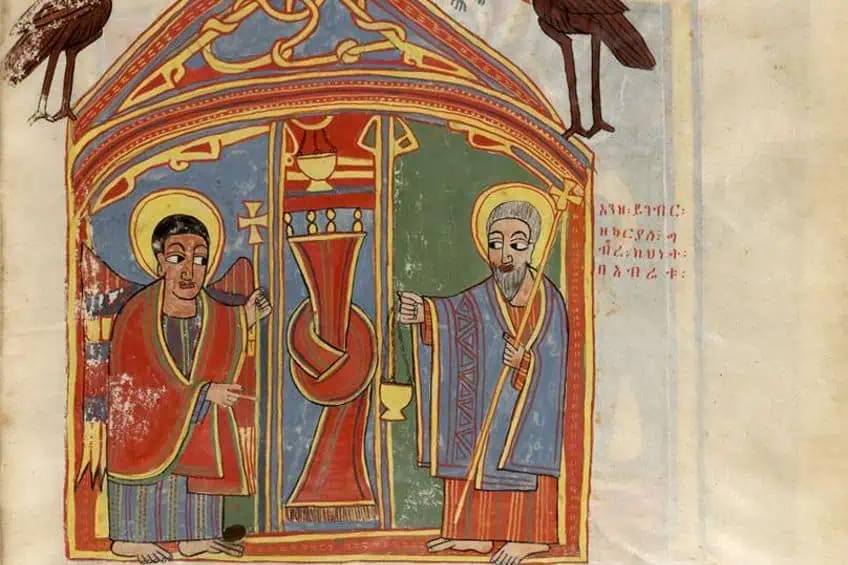Ethiopian Arts – An In-Depth Look at Ethiopian Art Culture
From paintings to illuminated manuscripts and intricate metalwork, the art of Ethiopia offers insight into the early cultures of the Ethiopian region, and reflects the ancient influences of Christianity. In this article, we will traverse through a history of the Ethiopian art scene and introduce you to some of the most intriguing Ethiopian artworks that shaped the foundation of Ethiopian art from antiquity to the Modern era.
An Introduction to the Early Ethiopian Arts
The Ethiopian arts are one of the most interesting sites for the study of not only human development but also art and the influence of Christianity on art in Eastern Africa. Ethiopia is one of the most looted countries in Eastern Africa as well as one of the earliest known sites of ochre processing. In other words, Ethiopia has historically been the site of some of the world’s earliest Christian-influenced artworks in Africa as well as housing one of the world’s first art studios.
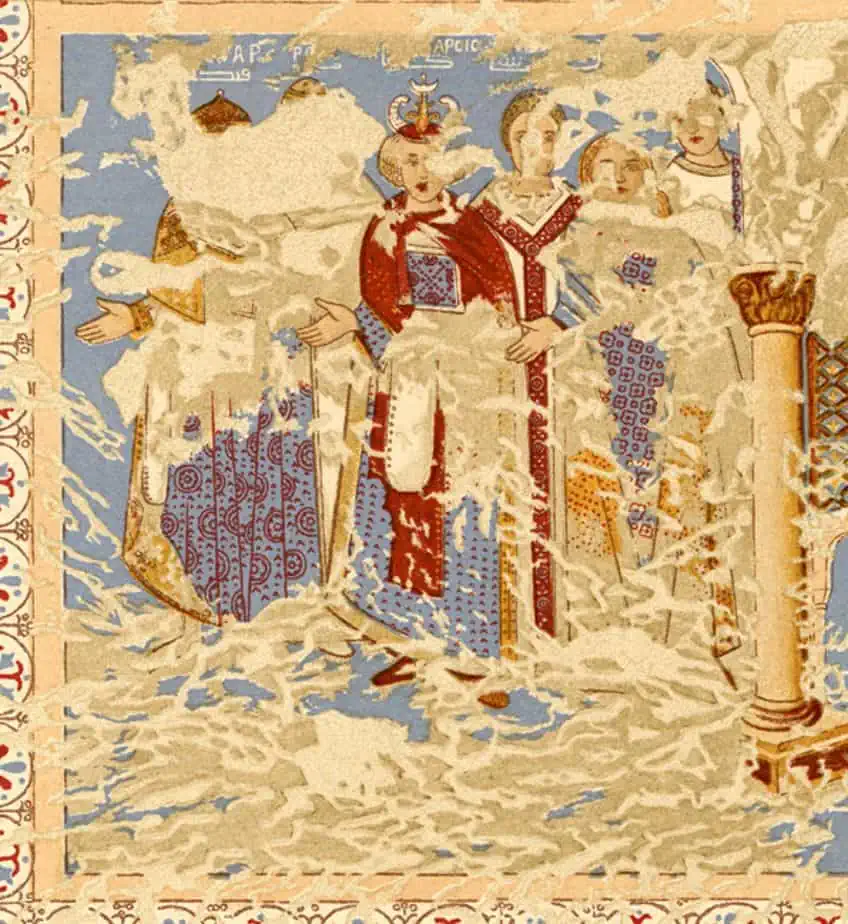
In Ethiopian art, culture had a major influence over the subject matter chosen and prioritized for artworks. It is important to acknowledge that the foundations of many early Ethiopian artworks emerged from the varying changes in culture, primarily activated after the introduction of Christianity in the country. Prehistoric Ethiopian art did exist before the influence of religion and displayed unique features such as bas-relief techniques, images of cows, geometric shapes, and anthropomorphic figures.
The Earliest Ochre Workshop
In 1929, a prehistoric cave dating to the Middle Stone Age (between 42,000 and 43,000 years ago) was discovered by French adventurer Henry de Monfreid and paleontologist and priest, Pierre Teilhard de Chardin. The Porc-Epic cave also housed nearly 90 pounds of natural pigment, which was then identified as the largest collection of ochre in East Africa. The diverse collection of ochre and pigmented stone was incredible and was the site of an ancient ochre processing workshop where artists would create a fine-grained vivid red powder by grinding the stones. Each powder would have a varying level of coarseness, which indicated the awareness of different textures and also included different shades of ochre in red, yellow, brown, gray, and orange.
Early art forms were linked to cultural practices and often found their use in body painting, medical treatments, stamps, and various mark-making tools for different functional purposes. It is more than likely that this production station was the source of many pigments for early Ethiopian paintings.
Important Sites for Prehistoric and Early Ethiopian Art
In Ethiopia, art can be found in many corners of the country that still reflect the early culture and artistic preferences of its inhabitants. Some of the most important sites for the exploration of early Ethiopian culture from the antiquities period include the rise of societies across Northern Ethiopia around the first millennium BCE. This included the Kingdom of Aksum, which was one of the greatest empires in the country’s history. Aksum began developing strong relations with international societies through the port of Adulis. Roman astronomer and mathematician Ptolemy also made mention of Aksum in the 2nd century BCE, drawing reference to Aksum as where the palace of the king was located. Ethiopia was also a major trade point with its access to the Nile Valley and the Red Sea, which allowed trade with Roman-run societies and thus the influence of Mediterranean and Eastern objects and materials.

Ethiopia’s exports included precious materials such as gold, ivory, salt, and myrrh, not forgetting, slavery. The demand for such items grew over the 3rd century BCE, which required the invention of a monetary system by coinage that resembled the design and standards to that of late Byzantine Roman coins. The kingdom of Aksum reached its peak as an empire after its expansion into present-day Yemen, in the region of former Saba. Other sites in Ethiopia that are crucial to the understanding of early Ethiopian art include sites such as Melka Kunture, the Omo Valley, the Adadi Mariam rock church, and various rock art sites around Harar and the Sidamo region.
Ancient Ethiopian Sculpture
The town of Tiya in central Ethiopia houses some of the best remaining ancient Ethiopian sculptures and features over 40 ancient stelae linked to early funerary practices. This mysterious cluster of stelae is one of the most intriguing art forms of early Ethiopian culture, which also contains interesting relief carvings on the stelae. A few of the identifiable symbols carved on the stelae include swords and anthropomorphic figures.
These Ethiopian sculptures were produced from single slabs of granite, which were discovered to be grave markers. Other texts carved on stone tablets from Aksum relay information about the introduction and acceptance of Christianity by emperor Ezana (c. 4th century), including the conquest of Yemen during the legalization of Christianity across the Roman empire by Constantine.
The Influence of Christianity on the Ancient Ethiopian Arts
In Ethiopia, art was strongly tied to one’s identification with the Christian ideology. As time passed, many Ethiopian leaders drew connections with Christianity and identified strongly with the narrative of the holy land and God’s chosen people. A text called the Kebra Nagast, translated in English to the Glory of Kings, mentions an Aksumite Queen called Makeda who journeyed to Jerusalem to visit king Solomon. The marriage of the two resulted in the next Ethiopian king, Menelek, who had to cross the Red Sea to claim his kingdom while in possession of the Ark of the Covenant, which is reportedly housed in the Our Lady Mary of Zion cathedral of Aksum.
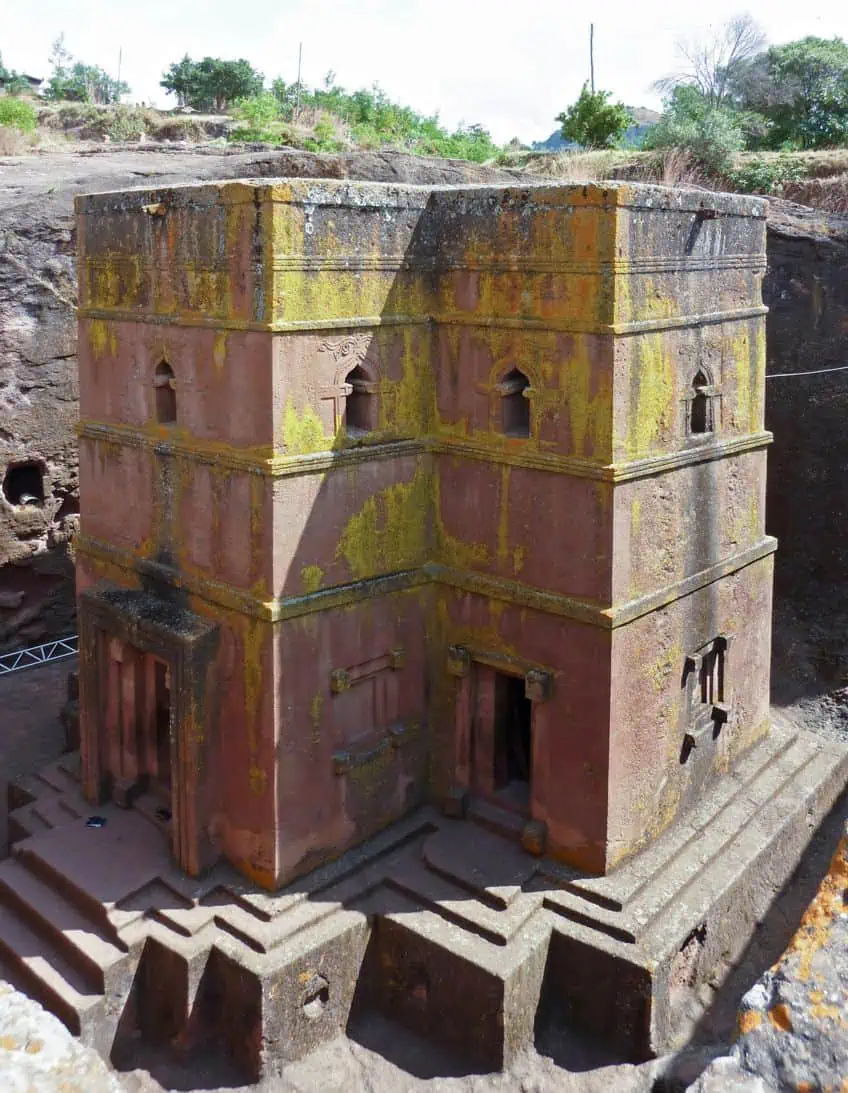
The cathedral was established during emperor Ezana’s reign and coincided with the introduction of the Orthodox church. This was also the site of coronation for many monarchs, which also roots itself in Jerusalem, known to be the last location of the Last Supper. The acceptance of the old testament by leadership in Ethiopian history was seen across the land with the establishment of many churches constructed out of the landscape itself. These churches were cut from the living rock and can be seen at sites such as the Tigray mountains in Lalibela, which date to the 13th century. Other structures such as monasteries in the same region were also integral to the spread of Christianity during the expansion of Ethiopia. Monasticism was popular among the aristocrats and was seen as another option to escape a career in politics. Such institutions were the site of art production as seen through the creation of illuminated manuscripts, processional crosses, and icons. These early art forms were made by monks for members of noble society who were patrons of the arts.
Below, we will look at a few examples of early art forms that demonstrated the artistic qualities of ancient Ethiopia as well as the influence of Christianity, which dominated Ethiopia.
Early Aksumite Coins
An important source for insight into ancient Ethiopian art styles can be seen in the Aksumite coins, which show the bust of King Endubis. These coins were incredibly significant to the study of ancient Ethiopian culture since they provided evidence that Ethiopian people possessed knowledge of both the Greek language and Ethiopic languages.
Gold Coin (c. 270 – 300 CE)
| Artist Name | King Endubis (Kingdom of Aksum) |
| Date | c. 270 – 300 CE |
| Medium | Gold, minted in Aksum (Ethiopia) |
| Dimensions (cm) | 1.57 (grams); Die-axis: 12 o’clock |
| Where It Is Housed | The British Museum, London, United Kingdom |
These were the first known coins produced for global trade and were even more so significant after a shift in design was made in the 4th century following the conversion of Ezana who replaced the original design with symbols of the cross, as seen in the gold coin below, dated to between 450 and 500 CE).
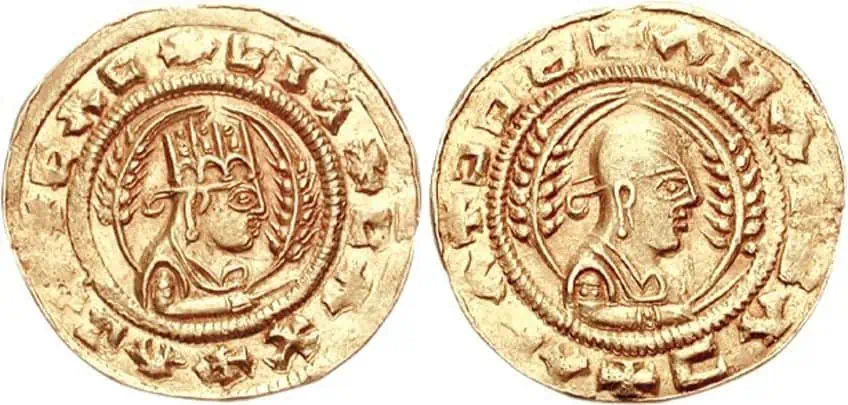
Gold Coin (c. 450 – 500 CE)
| Artist Name | King Ebana (Kingdom of Aksum) |
| Date | c. 450 – 500 CE |
| Medium | Gold, minted in Aksum (Ethiopia) |
| Dimensions (cm) | 1.57 (grams); Die-axis: 12 o’clock |
| Where It Is Housed | The British Museum, London, United Kingdom |
This simple design change was anything but simple. The change signified the impact and influence that Christianity had on Ethiopia, including its apparent widespread adoption as an important symbol for Ethiopia. The gold coin above showcases a bust of King Ebana who is seen with two wheat stalks next to him and wearing a head cloth or crown. The British Museum houses around 310 gold coins, which are not on display. The majority of coins in the collection were sold to the museum by Roger Brereton in the late 20th century and consisted of 553 coins from the Aksumite era, which he accumulated while staying in Ethiopia. Earlier examples of gold coins from the Aksumite era can be seen entering the British collection around 1925, donated from Yemen by a military individual, and in 1904 from Ali Farah in Yemen. Many of the Aksumite gold coins were found inscribed with the Greek alphabet, which illustrated the intention for exportation while copper and white silver coins were inscribed in an Aksumite script called Ge’ez.
The 4th century saw a large number of copper coins issued with Christian inscriptions such as “he conquers through Christ” and messages of joy and peace for the people.
Illuminated Manuscripts of Early Ethiopia
Illuminated manuscripts were another important surviving art form of Aksum that offer a glimpse into the artistic potential that early monasteries contained. The churches of the Aksumite era followed the basilica structure and were built in the style and technique of local architecture and design despite not many manuscripts surviving from the Aksumite era, one can look to the Garima Gospels to further review the early artistic technique and style of 4th through to 15th century-Ethiopian paintings. Below, you will find a few examples of illuminated manuscripts that showcase the importance of holy texts and their relationship to art.
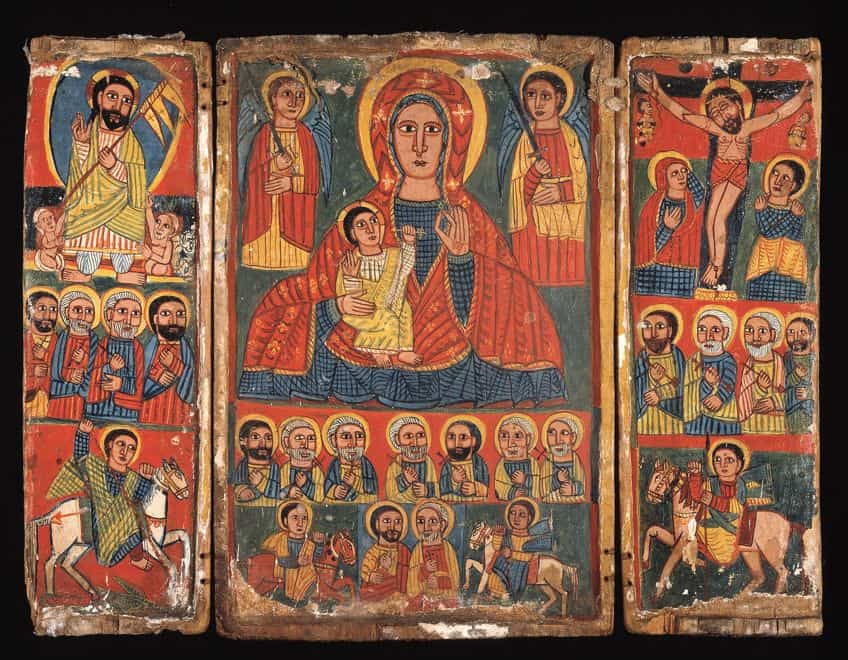
The Garima Gospels
You cannot discuss the history of Ethiopian arts without mentioning the Garima Gospels. These manuscripts are a rare pair of books that date back to the Aksumite period and are considered to be the earliest surviving Christian manuscripts from East Africa. Dating suggests that one of the manuscripts was created around the year 500 CE and another between the 4th and 6th centuries. These manuscripts are incredibly important to the understanding of early Ethiopian artwork through painting and calligraphy as well as the earliest versions of an Ethiopic Christian version of the Gospels. Upon paleographic analyses, researchers believe the books date to around 1100 CE.
The manuscripts are currently located at the Abba Garima monastery and have not left the monastery since their creation. The creator of the gospels is credited to Saint Abba Garima who operated during the close of the 5th century. It is believed that Abba Garima was one of nine saints who traveled from Rome or Syria to “Christianizing” the locals of the 6th century. The manuscripts were considered to be sacred objects of the saint as opposed to antiquity objects.
However, the dating of the manuscripts contradicts the narrative that the books were produced by Garima and the possibility that the origin of the script was Syrian.
Garima 2 of the manuscripts contain 17 illuminated pages that feature Ethiopian paintings and portraits of the evangelists as well as Christian Greek historian, Eusebius of Caesarea, and the temple of Solomon. The manuscript also contains Byzantine-styled miniaturist paintings, of which the Byzantine style was used as foundational models from which early artists in the monasteries developed their tastes in favor of two-dimensional designs, elements of abstraction, and bold colors.
The manuscripts did not contain any information about the purpose of the book, but in Garima II, the text mentioned records of church repairs ordered by King Armeho who was later recognized as Armah of Axum. The covers of the manuscripts were also once embellished with jewels and are recognized as one of the oldest book covers in the world with the covers on Garima 2 dating between the 10th and the 12th centuries. Since the manuscripts’ modern discovery in 1950, they have remained the topic of interest for many scholars in the fields of Byzantine studies, Ethiopian art, and its context in antiquity art history.
Illuminated Gospel (c. 14th – 15th Century)
| Artist Name | Unknown |
| Date | c. 14th – 15th centuries |
| Medium | Parchment (vellum), wood (acacia), tempera, and ink |
| Dimensions (cm) | 41.9 x 28.6 x 10.2 |
| Where It Is Housed | The Metropolitan Museum of Art, New York City, United States |
These late 14th-century gospels were created at a North Ethiopian monastery and feature 20 full-page drawings showcasing scenes from Jesus Christ’s life in addition to four evangelist portraits. These gospels are one of the most treasured paintings from the Amhara region and serve as evidence of the complex relations of sub-Saharan Africa with Eastern Mediterranean, Egyptian, and Arabian regions. The birth of civilization in the highlands of Ethiopia was pinpointed to 6 BCE after Arabian emigrants united with indigenous people and formed the Kingdom of Aksum.
The text from the new testament of the bible had been translated from Greek into Geez around the 6th century, thus making access to the Christian teachings a lot easier. The style of the paintings reflects Byzantine models, which were believed to have been created by two separate artists who used the Byzantine models to create unique stylized images. The images also display a high level of uniformity across the works. This can be seen in the color palette, the facial expressions, and the depiction of the human figure in red and black. The figures are incredibly fascinating since the human form is treated as though it is columnar and covered in textiles as highlighted by the striated markings.
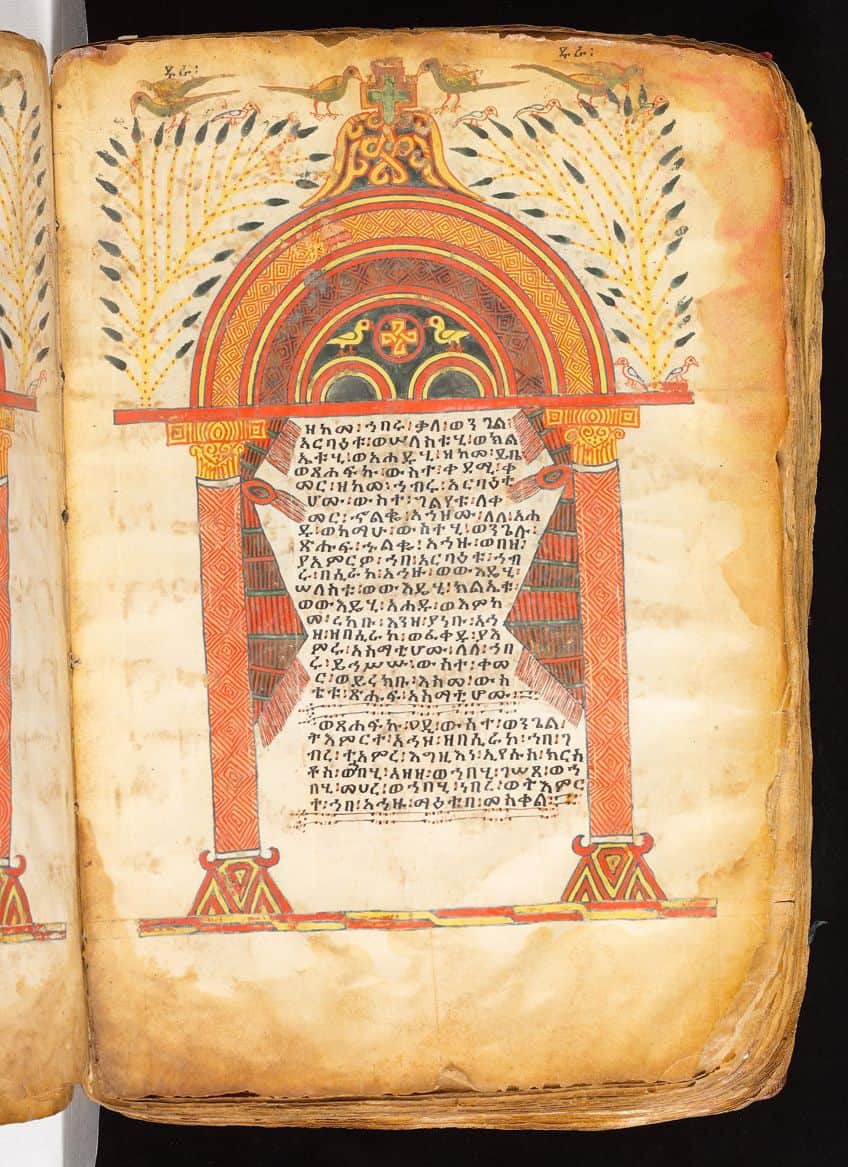
When King Ezana converted to Christianity in 4 CE, Christianity was established as the official religion of the state, which has remained one of the leading religions in Ethiopia. Today, Orthodox Christianity dominates the Christian faith in Ethiopia and has maintained its influence over the arts, including the decorative arts, painting, metalwork, and wood carving. The text of the gospels is considered to be important holy texts created for viewing during liturgical processions and were presented by patrons to the church.
According to researchers, it is believed that these manuscripts were presented to a church established in honor of Archangel Michael. The paintings illustrate a strong focus on detail and geometric motifs that decorate the architecturally-based Ethiopian artwork. The images also contain many arch-shaped motifs and columns that remind one of ancient Roman architecture. Other interesting images in the manuscript include images of birds that contrast with images of angel-like creatures presiding over a crowd of followers in addition to the depiction of the cross, which seems embedded in the “architecture”.
An interesting note about the manuscripts and icon paintings is that many of the Ethiopian artworks did not mention the artist or contain signatures due to the intention behind the work. These icon works served their primary purpose aimed at the glorification of God and thus no trace of workshop branding or an artist’s name would traditionally be found.
Metalwork in Ethiopia
While many icon paintings were housed in churches, other forms of art such as metalwork were also important in keeping the traditions of the church alive. The development of the cross over time can be seen in the use of Coptic-styled crosses constructed from metal and wood. Originally believed to be crafted in gold or silver, crosses are commonly flat-cast plates featuring complex and intricate open designs. What is even more interesting is that the cross emerges from the design, which usually takes the shape of a rotated square or circle. Some of the cross designs include curved motifs that emerge from the base of the cross and are referred to as the “arms of Adam” with many other smaller crosses embedded in the design as seen in Western-influenced designs. These metal crosses are then mounted on wooden staffs and become processional crosses used during public liturgy ceremonies.
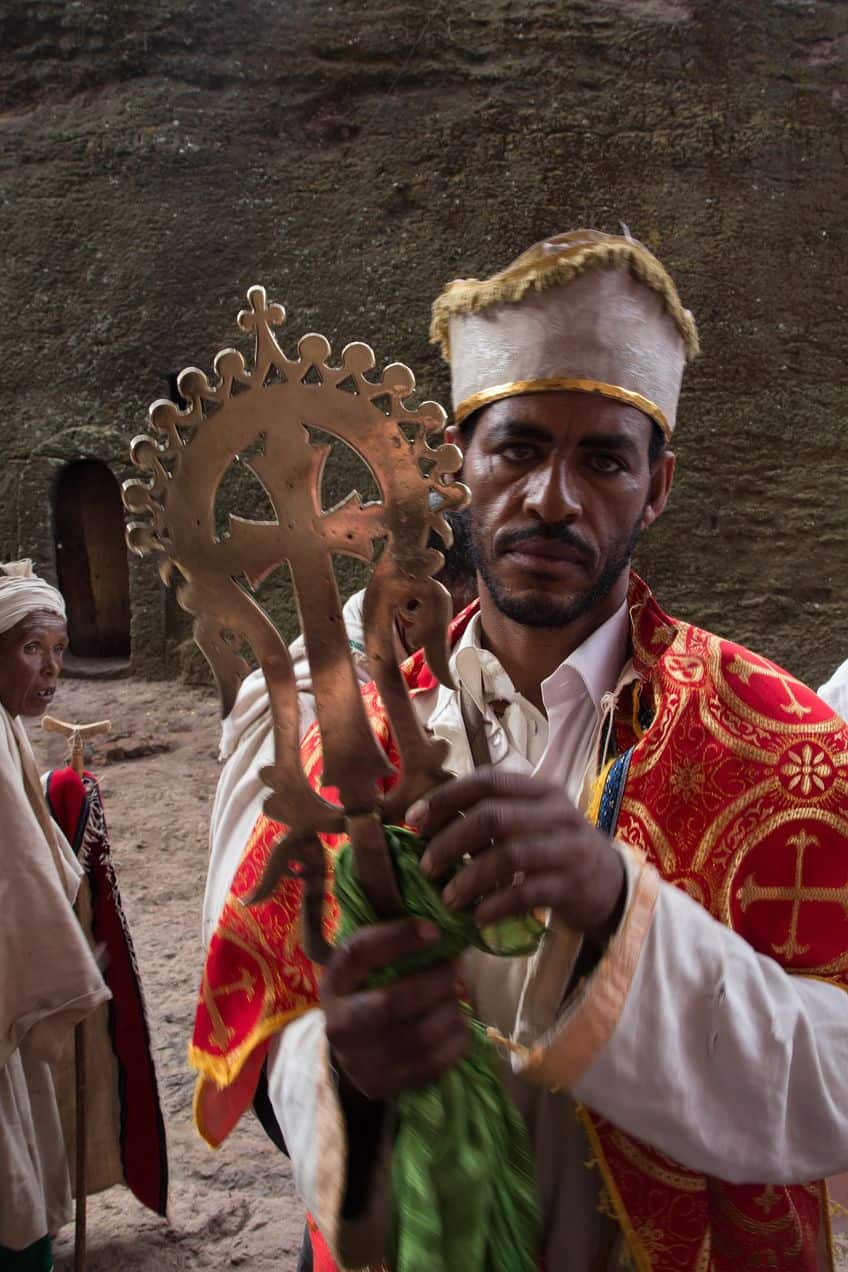
Lalibela Cross (c. 12th Century)
| Artist Name | Unknown; believed to be commissioned by King Laibela |
| Date | c. 12th century |
| Medium | Gold or bronze and gold |
| Dimensions (cm) | 60 (l); 7 (kg) |
| Where It Is Housed | Bet Medhane Alem, Lalibela, Ethiopia |
The Lalibela Cross is perhaps the most treasured religious art object of Ethiopia belonging to the 12th-century church called the Bet Medhane Alem church. The cross is also identified as Afro Ayigeba and is a large processional object crafted from gold. The artifact is incredibly significant to the culture and heritage of Ethiopia as well as its religious significance to the rock-carved church established by King Laibela. The church is one of 11 other churches in the vicinity that house important artifacts and scrolls. In 1997, the Lalibela Cross was stolen and a worldwide manhunt for the cross ensued, lasting two years. The cross was recovered after being found in the private collection of a Belgian businessman and collector in 1999.
The cross then returned to the church in 2001 where it remains today.
Art in the Solomonic Period
By the latter stage of the 13th century, Ethiopia saw an increase in attention paid to the design and the elaborate thinking put into the construction of rock-carved churches. The town of Lalibela is an incredible point from which to study the art of this period as the churches were seen as the walls on which artists would express their devotion to the faith. Churches such as Bete Maryam and Bete Gyorgis are great examples of Aksumite-inspired architecture as well as the beautiful wall paintings of the Zagwe period. The paintings at Bete Maryam have been compared with the paintings found at the monastery of St. Anthony near the Red Sea.
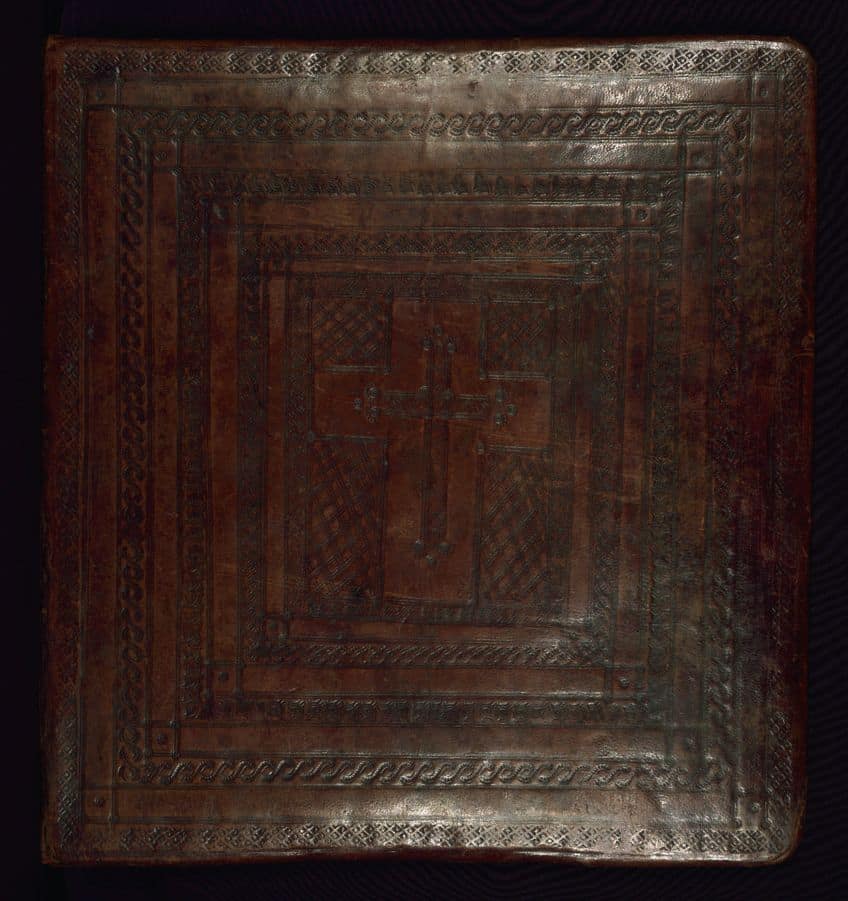
After Ethiopia was overtaken by the rulership of Yekunno Amlak who proved his lineage through his affiliation with the Queen of Sheba and King Solomon, the Solomonics emerged after him. The Solomonics were avid supporters of the arts and bestowed many gifts to the churches. The church of Ganata Maryam houses a set of murals that portrays scenes from the New Testament, including a portrait of Yekunno Amlak. Between the 13th and 15th centuries, many illuminated manuscripts were produced, which introduced imagery from both the old and new testaments, including Psalters (books based on the book of Psalms).
A Period of Instability
The 16th to the early 17th centuries saw a period of instability, which overturned the Ethiopian kingdom. Many churches and artworks from the 16th century were destroyed during the invasion of the Muslim Sultanate of Adal. Following this, a civil war sparked by the conversion to Catholicism under Emperor Susenyos was what contributed to the growing rage of the people and resulted in many choosing to abandon the practices enforced by the Jesuit missionaries. This turbulent century can be identified as a transitional period in art, which reflected inspiration from the 15th century through iconographic elements and styles while demonstrating new elements of the upcoming 17th century.
By this time, the use of geometric motifs and the inclusion of images in manuscripts decreased.
The Establishment of Gondar and the Era of Judges
Emperor Susenyos’ son, Fasilides took over the throne in 1632 and founded a new capital in Gondar, which saw the establishment of many palaces and churches around the Lake Tana region. This period also saw the replacement of the basilica plan with the circular plan for church construction. The art style of the time also saw the introduction of brighter colors and a reduction in shading. This shading was replaced by solid inlays of color with decorations and in clothing, the illustration of folds with basic parallel lines. The shade coral red was also used to portray faces, which gave the period its unique unnatural appearance while maintaining solid contours.
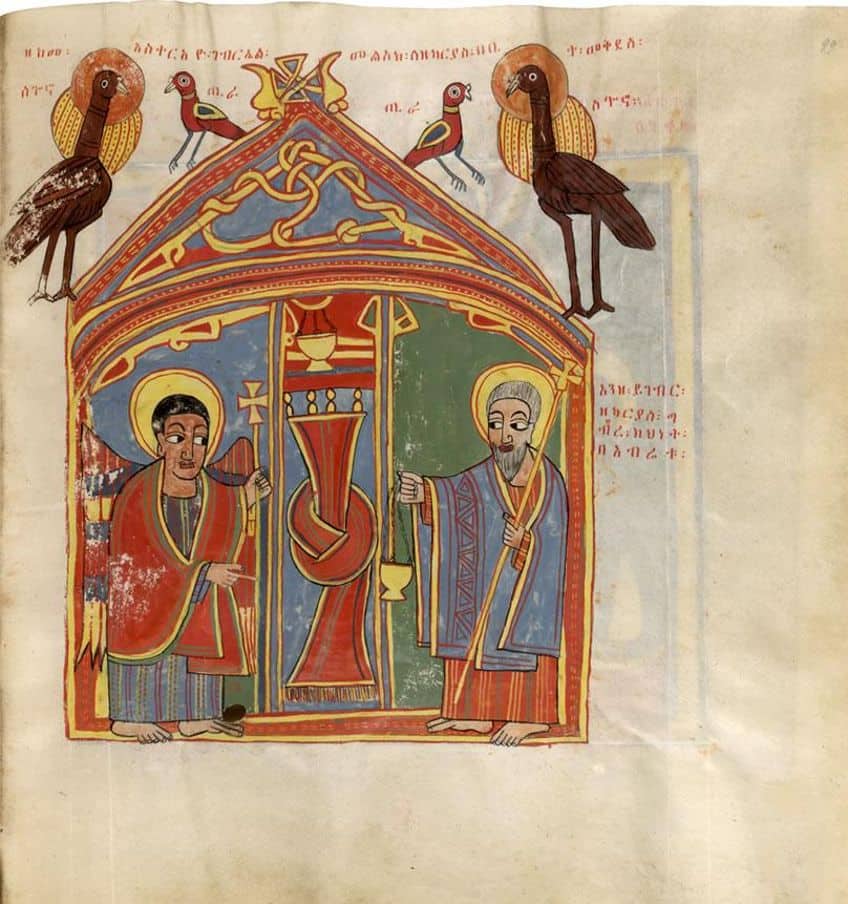
The 18th century produced another style, which saw the reduction of the contour line with darker shades and the introduction of patrons and donors in paintings. Processional crosses were also decorated with images of Mary and the saints. The era of judges marked by the Zemene Mesafint period between the mid-18th century and the first half of the 19th century witnessed the rise of warlords coupled with a decline in art production. This period saw the re-introduction of bright colors in art. Following this period, many contemporary figures emerged alongside religious subjects and saw an increase in the preference for realistic depictions.
Development of Modern and Contemporary Ethiopian Art
The 20th century marked a turning point for Ethiopian art through the introduction of Modern art styles by artists who pursued art education in Europe and Ethiopia and integrated Modern art styles into Ethiopian subject matter. Despite not being labeled as a “colonized country”, Ethiopia has certainly been pivotal in aiding the benefit of many other countries. Ethiopian artists such as Afewerk Tekle have, for instance, highlighted the role of artists in Ethiopia through his experience with having to “work his way up” to the global stage while navigating his identity as an artist and resident of Ethiopia, a country rooted in Christianity and dependent on the success of academic residents to rebuild a new Ethiopia.
Tekle was of Amhara descent and was born in Ankober under the occupation of the Italian empire. Along with a group of students, Tekle was elected to study in England and even received a pep-talk from Emperor Haile Selassie who highlighted the mission of the program, to “work hard…and return with the skills and mindset to rebuild Ethiopia”.
Total Liberation of Africa (c. 1958 – 1961) by Afewerk Tekle
| Artist Name | Afewerk Tekle (1932 – 2012) |
| Date | c. 1958 – 1961 |
| Medium | Stained glass |
| Dimensions (m2) | 150 |
| Where It Is Housed | Africa Hall, Addis Ababa, Ethiopia |
In 1958, Tekle created this magnificent stained-glass artwork for installation in the United Nations Economic Commission for Africa headquarters, the Africa Hall. Tekle set aside approximately 12 days for the planning of the artwork and finalized his design within the time frame. Tekle’s statement on the artwork was directed at the fact that he disagreed with the notion that Africa was recognized only for housing the great sphinx and it was more than just a continent made up of colonies. The theme of the artwork was built on the title of “Africa then, African now, and Africa in the future”, which cemented his standpoint and made evident the profound messages concerning the continent as a whole in light of Africa’s history of colonization. The stained-glass artwork is divided into three windows spread across 150 square meters of space.
The aftermath of the commission was well-received yet Tekle was left unpaid for his contribution for over two years. After continuous struggles to receive payment, he was met with the fact that he would never be paid yet remained grateful that his work helped gain him global recognition and praise. Some of the art styles that emerged in the 20th century were founded on a sense of nationalism, which was reflected in painting styles that showcased more naturalistic and realistic representations of glamor. Other themes that emerged involve artists engaging with the exploration of Ethiopian identity and spirituality through Expressionism, Surrealism, and Abstraction. The mid-to-the late 20th century saw political upheaval, which resulted in the establishment of the Ethiopian Artists Association. This period also saw the use of artists in political propaganda tactics as agents at the forefront of Social Realism. Post-1993, the association grew increasingly silent, which resulted in a rise in individual artists.
Since then, other groups emerged to bolster the artistic drive of the Ethiopian art scene, including groups such as Addis International, Friendship of Women Artists, Double Blue, and the Point and Dimension groups. Graduates of the Addis Ababa Fine Arts School have also contributed to the late 20th-century artscape, which focused mainly on social commentary with Addis Ababa growing to become the art hub of Ethiopia.
Other famous Ethiopian artists who dominated the 20th century include artists like Adamu Tesfaw, Agegnehu Engida, Ale Felege Selam Heruy, Lemma Guya, Zerihun Yetmgeta Yetmgeta, Mickaël Bethe-Selassié, and Tadesse Mamecha, all of whom have played a role in broadening the art styles of the Contemporary period.
Frequently Asked Questions
What Art Forms Were Practiced in Ancient Ethiopia?
Art forms that were practiced in ancient Ethiopia include metalwork, textile art, illuminated manuscripts, monumental sculptures, relief carvings, and wall paintings.
What Language Did Ancient Ethiopians Speak?
Ancient Ethiopian civilizations spoke a preceding language called Ge’ ez, which is the root language of the current Tigré and Tigrinya languages from Eritrea and Ethiopia. Ge’ ez is considered to be the father of all languages and is estimated to be at least 5,000 years old.
What Was the Impact of Christianity on Ethiopian Art?
In Ethiopian art, culture and Christianity played a huge role in the subject matter and artistic preferences of artists in Ethiopia. Numerous churches were established and the arts sector was initially heavily intertwined with the production of art that venerated religious icons. Illuminated manuscripts contained paintings that were viewed as part of holy texts and were special aspects of the Christian faith that dominated Ethiopia. Ethiopian art became increasingly connected with Christianity due to its strong ties with the introduction and widespread adoption of the religion over many centuries. More Contemporary themes move away from Christian-based subject matter and more toward the individual experiences of the culture and identity at play with the country’s political history and the broader context of the world.
Jordan Anthony is a Cape Town-based film photographer, curator, and arts writer. She holds a Bachelor of Art in Fine Arts from the University of the Witwatersrand, Johannesburg, where she explored themes like healing, identity, dreams, and intuitive creation in her Contemporary art practice. Jordan has collaborated with various local art institutions, including the KZNSA Gallery in Durban, the Turbine Art Fair, and the Wits Art Museum. Her photography focuses on abstract color manipulations, portraiture, candid shots, and urban landscapes. She’s intrigued by philosophy, memory, and esotericism, drawing inspiration from Surrealism, Fluxus, and ancient civilizations, as well as childhood influences and found objects. Jordan is working for artfilemagazine since 2022 and writes blog posts about art history and photography.
Learn more about Jordan Anthony and about us.
Cite this Article
Jordan, Anthony, “Ethiopian Arts – An In-Depth Look at Ethiopian Art Culture.” artfilemagazine – Your Online Art Source. March 23, 2023. URL: https://artfilemagazine.com/ethiopian-arts/
Anthony, J. (2023, 23 March). Ethiopian Arts – An In-Depth Look at Ethiopian Art Culture. artfilemagazine – Your Online Art Source. https://artfilemagazine.com/ethiopian-arts/
Anthony, Jordan. “Ethiopian Arts – An In-Depth Look at Ethiopian Art Culture.” artfilemagazine – Your Online Art Source, March 23, 2023. https://artfilemagazine.com/ethiopian-arts/.


